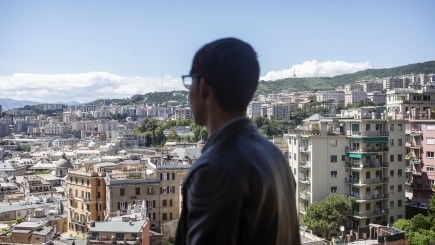
Genoa, Italy. After fleeing violence, this Afghan boy crossed two continents alone to be reunited with his siblings.
© UNHCR/Dario Bosio
Content of this page:
1. Description of the refugee situation
2. Italy's response to the refugee situation
3. Steps towards meeting the objectives of the Compact
1. Description of context
Where does the population of concern live?
- Refugees - Location : Camps/settlements (rural/urban) - Total : 90.000
- Asylum Seekers - Total: 46.000
- Stateless - Total: 822 ((official number from ISTAT, UNHCR estimates differ hereof)
Find live data, information and fact sheets on the refugee situation in Italy on the UNHCR Operational Portal as well as on Global Focus.
2. Italy's response to the refugee situation
Italy has not yet established formal national coordination arrangements for the implementation of the Global Compact on Refugees due to multiple factors, including the change of Government in early September 2019, a low visibility approach on migration issues as opposed to the previous Government, and the non-signature of the Global Compact on Migration. Nonetheless, Italy has set up three thematic operational coordination mechanisms for specific complementary pathways and solutions, in line with the objective of the GCR.
For the Humanitarian Evacuations, through which Italy has safely evacuated more than 800 vulnerable persons of concern from Libya and Niger since 2017, Italy has set up a coordination body, including the Ministries of Interior and of Foreign Affairs, the Italian National Health Care Service, Italian National Police, the National Institute for Health, Migration and Poverty (NIHMP), UNHCR and airport authorities.
The coordination of the National Resettlement scheme foresees periodic meetings between similar entities, with the addition of the European Union.
Similarly, the Humanitarian Corridors initiative, which have granted safe and legal access to Italy to more than 2,100 individuals in the past four years, brought together the same actors, and Caritas Italy, Community Sant’Egidio, the Italian Episcopal Conference and the Waldensian Board.
Finally, in 2019, a UN working group on Migration and Refugees was established by UNHCR, IOM and UNICEF.
Partnerships in the refugee response
Italy has been an innovative champion for the expansion of access to third country solutions (namely through its Humanitarian Corridors and Humanitarian Evacuations programmes). In 2019, the Humanitarian Corridors was awarded the regional Nansen award honouring the uniqueness and the multi-stakeholder spirit of this initiative.
In order to implement innovative third-country solutions through a whole-of-society approach, Italy has established various agreements to facilitate the collaboration between line ministries, community- and faith-based organisations, Universities, and other partners such as UNHCR. Through the Humanitarian Corridors, more than 2,000 persons of concern have been transferred to Italy and France from Jordan, Lebanon, Niger and Ethiopia.
In the spirit of strengthening refugee self-reliance, in line with the GCR, several innovative community-based programmes have been established in Italy. In partnership between INTERSOS and UNHCR, the PartecipAzione programme seeks to build the capacity of refugee-led and community-based organizations to promote refugee empowerment and enhance social cohesion with local communities. The programme will be implemented by a wide range of stakeholders at different levels, including private foundations, local institutional, local and national media, research institutes and cultural associations.
Partners involved:
- Line Ministries
- Local government
- UN Agencies
- National NGOs
- International NGOs
- Private Sector
- Others
For a full list of partners, please see the attached PDF document on the right-hand side of the article.
3. Steps towards meeting the objectives of the Compact
Summary of the Refugee Compact in action in Italy.
Italy’s multi-functional response primarily has sought to achieve the third objectives of the GCR, in other words facilitating access to durable solutions, specifically to explore legal pathways for the admission of persons with international protection needs to third countries:
- The Italian Government and a number of faith-based organizations (Comunità Sant’ Egidio, Caritas Italiana, Waldensian Board and Evangelical Churches) set up Humanitarian Corridors that enabled the transfer of 600 Persons of Concern to Italy from Ethiopia, Niger and Jordan in 2019.
- Supporting greater access to education, an agreement between the Ministry of Foreign Affairs and UNHCR, in partnership with the University of Bologna and faith-based organisations, provided opportunities for access to higher education in Italy as a legal pathway.
- Since the end of 2017, Italy has safely evacuated more than 800 vulnerable persons of concern from Libya and Niger under the Humanitarian Evacuations scheme.
- Through the National Resettlement scheme, since 2015, Italy has resettled 2,300 persons.
Italy has contributed to projects aimed at enhancing jobs and livelihoods opportunities, in line with Objective 2 of the GCR:
- The Government is supporting a series of initiatives and projects aiming at promoting economic opportunities and job inclusion with the Government, national civil society organisations such as Cambalache, Fondazione Adecco, and Università Pollenzo and a business community network.
- Many companies that promote the inclusion of refugee employees receive the Welcome Project, involving 120 companies employing 2,850 refugees.
- Through Refugees welcome - a civil society initiative dedicated to hosting refugees in local families and promoting refugee inclusion - 126 refugees were matched to local families in 18 cities in Italy over the course of three years.
Pledges and contributions made by Italy
Pledges and contributions dashboard (interactive by Area of Focus)
This dashboard includes all pledges and contributions made towards the implementation of the Global Compact on Refugees in Italy, including national pledges made by the Government of Italy itself.





